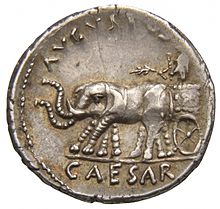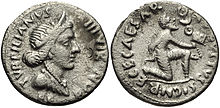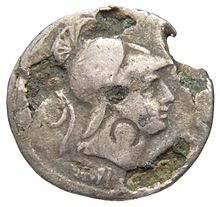Publius Petronius Turpilianus (Mint Master)
Publius Petronius Turpilianus was a mint master of the early Roman Empire.
Origin and family
Publius Petronius Turpilianus was probably a son of Publius Petronius , who lived from 25/24 to 22/21 BC. Is attested as a prefect of Egypt . Possibly his mother was a Turpilia and Petronius Turpilianus a descendant of the poet Turpilius . He is commonly believed to be the father of the augur Publius Petronius (suffect consul 19 AD) and Gaius Petronius (suffect consul 25) .
Life
Almost nothing is known about the life of the mint master. It has been suggested that Petronius Turpilianus took office in 20 BC. As a kind of reward for his father's deeds in Ethiopia. Not infrequently, the office of mint master was a social (and probably also a financial) springboard for young knights, and so the Petronius family was likely to have risen to the rank of senator at this time. Petronius Turpilianus may be identical to the one around 6/5 BC. Proconsul of the same name of Hispania Baetica mentioned in an inscription . The capital of the southern Spanish province of Baetica was the economic metropolis of Corduba, where L. Annaeus Seneca ("the elder"), later known as the rhetorician, lived with his wife Helvia as trustee or civil servant.
plant
Common motives of the three mint masters: Augustan propaganda
The motifs used jointly by the three mint masters P. Petronius Turpilianus, Aquillius Florus and M. Durmius have a clear reference to current political and social events under Augustus:
- A man with an olive branch drives a biga that is being pulled by two elephants . The coin celebrates the Indian embassy in 20 BC. Chr.
- A gold coin from this period contains the letters OCS (= ob civis servatos ) and below it AUGUSTUS in an oak wreath . (The corona civica consisting of oak leaves was awarded for the rescue of a Roman citizen). This coin is extremely rare, only about five pieces have survived; a copy recently fetched 21,000 Swiss francs at auction.
- Particularly important for Augustus' self-portrayal was the return of the standard symbols lost by Crassus by the Parthian King Phraates, also in the year 20 BC. Chr .: A kneeling man hands over the standard sign ( sign [ is ] rece [ ptis ]).
- In the same year (20 BC) a kneeling Armenian testified to the conquest of Armenia: ARME [NIA]. CAPT [A].
- The quadriga is also a symbol of triumph and may celebrate the return of Augustus in the year 19. It is unclear what the Senatus consultum (SC) is referring to on this coin.
Special issues of Petronius
The aforementioned motifs can be found on all three mint masters. But each of them also has coins with their own symbols. Aquillius Florus shows his name very clearly with a flower, next to it there is a coin image of an enemy who was thrown down by a soldier. M. Durmius, however, shows a boar pierced by a spear, a deer torn by a lion and a bull. The most famous of his coins is probably the one that shows a crab and a butterfly.
Petronius Turpilianus created many of his own motifs. They are characterized by their special beauty and original motifs.
First of all, the motifs on the front of the coin are striking, depicting not only Augustus, but also the god of war Mars and often two Italian natural deities, the goddess Feronia and the god Liber, who is equated with Dionysus.
- Feronia was the (probably originally Etruscan) goddess of twilight (Varro calls her Sabine). Their temple was near Tarracina, which Petronius Arbiter , probably a grandson of the mint master, mentions in his Satyricon . Once a year the followers of the goddess wandered through the coals and glow ash with bare feet at a big festival. Feronia was also the goddess of marketplaces and markets. If one was generous with her, she was mild, but if not, she bewitched children and cattle. And indeed a lot was sacrificed to her, not least the freedmen of Rome provided the temple with plenty of money. The temple treasures grew with gold and silver in ancient times until Hannibal plundered them. Feronia as a coin image is thus an appreciation of the freedmen and at the same time the barely veiled invitation to trade generously. The use by Petronius Turpilianus could indicate a Sabine descent of the Gens Petronia.
- Liber and Libera were worshiped together with Ceres in a temple that was built by the dictator Aulus Postumius in 495 BC. It is said to have been consecrated after one consulted the Sibylline books, which allegedly a Petronius Sabinus had copied. This could also be understood as an indication of the Sabine origin of the Gens Petronia. Incidentally, Petronius Arbiter also plays with the name of the god Liber in Satyricon .
The reverse sides of the coin are particularly important for Petronius' self-portrayal :
- The unchaste vestal virgin Tarpeia , who opened the gates of Rome out of love for the hostile Sabine king, is buried alive under shields. The portrayal of Tarpeia, a friend of the Sabines, also suggested that this mint master had Sabine descent. This is a bit questionable, at least because of the inglorious role of Tarpeia. However, the mint master L. Titurius Sabinus [!] Already used in 89 BC BC also the motif of the Tarpeia, according to Welch the coin of Petronius goes back directly to his earlier minted denarius. A reference to current politics seems somewhat more obvious:
- In the year 18 Augustus passed three laws: the lex Iulia de ambitu (on corruption), the lex Iulia de maritandis ordinibus (on the marital order - childlessness is disadvantaged) and the lex Iulia de adulteriis coercendis (to prevent adultery). The coins of Petronius act like the propagandistic underpinning of this policy: whoever accepts a bribe and becomes unfaithful like Tarpeia once did, will receive his punishment: "the traitor is an abomination even to the beneficiary". The motif was known in the Mäcenas circle. Surprisingly, Properz interprets an elegy as the result of a difference between religion and morality. Some date this coin to the year 16 BC. Recently a joking reference by Turpilianus to the first line of propertius' elegy 4.4 is suspected: Tarpeiae turpe [!] Sepulchrum (the ugly grave of Tarpeia).
- The depiction of the sun (?) And the crescent moon could also be part of Augustan propaganda and underline the claim to world domination cosmologically. In Virgil's Aeneid it says: "externi uenient generi, qui sanguine nostrum / nomen in astra ferant, quorumque a stirpe nepotes / omnia sub pedibus, qua sol utrumque recurrens / aspicit Oceanum, uertique regique uidebunt". (“There come suitors from afar, who are to carry our name to the stars with their blood, and the descendants of their sex become all the lands that Sol overlooks when he rises out of the ocean and when he descends into it, at his feet Throw. ”) Allegedly the divine Caesar, the (adoptive) father of Augustus, turned into a star ( Sidus Iulius ).
Further motifs aim in the direction of poetry and singing:
- A winged siren , a trumpet in each hand.
- The winged Pegasus is undoubtedly one of the most beautiful forms of Petronius. The noble horse produced with its hoofbeat the "heliconic spring" from which all poets drink.
- The lyre with turtle shell is said to have been invented by the god Hermes, in which he misused a turtle.
- Finally there is even a pan with a syrinx (“pan flute”!) And a pedum (shepherd's crook) and a young satyr sitting , his chin pensively in his right hand, a double flute between his crossed legs.
These motifs have been linked to the death of the poet Virgil in the year 19. The siren was an artistically singing angel of death, the Pegasus points to the source of the Muses, the lyre to the invention of lyrical poetry by Hermes, the Pan to the invention of the shepherd's flute and thus clearly enough to the works and death of Virgil. After an epigram of Domitius Marsus died simultaneously with Virgil the poet Tibullus . Internal reasons for his poetry suggest, however, that the death of Tibullus was not until the year 17 or later.
But it has also been assumed that the mint master Turpilianus adored his ancestor, the comedy poet Turpilius, with these coins . About three generations before Turpilianus, he wrote the popular palliata, which are mainly praised for their metric diversity and linguistic colourfulness. The grace of his numerous comedies helped him to the honorary title Novella Sirena , which could at least explain the coin motif of the siren in Turpilianus casually.
literature
- Celestino Cavedoni : Nuove congetture intorno ad alcuni tipi delle monete di P. Petronio Turpiliano triunviro sotto Augusto nell'anno di Roma 735. In: Bullettino archeologico napoletano New series, 5th year 1856/1857, pp. 105-108 ( [1] ).
- Philip Smith: Turpilianus, Petronius . In: William Smith (Ed.): Dictionary of Greek and Roman Biography and Mythology . tape 3 : Oarses-Zygia and Zygius . Little, Brown and Company, Boston 1870, p. 1192 (English, Textarchiv - Internet Archive ).
- Edmund Groag : Petronius 74. In: Paulys Realencyclopädie der classischen Antiquity Science (RE). Volume XIX, 1, Stuttgart 1937, column 1227 f.
- Herbert Appold Grueber: Coins of the Roman Republic in the British Museum. In three volumes. Original edition 1910, reprinted Oxford 1970.
- H. Mattingly: The Date of Virgil's Death: A Numismatic Contribution. In: The Classical Review. Volume 44, No. 2, 1930, pp. 57-59.
- Anne S. Robertson: Roman Imperial Coins in the Hunter Coin Cabinet University of Glasgow. I. Augustus to Nerva. London / Glasgow / New York 1962.
- JR Jones: Mint Magistrates in the Early Roman Empire. In: Bulletin of the Institute of Classical Studies 17, 1970, pp. 70-78.
- Aase Bay: The Letters SC on Augustan Aes Coinage. In: Journal of Roman Studies 62, 1972, pp. 111-122.
- Jean-Baptiste Giard: Catalog des monnaies de l'empire romain. I. Auguste. Paris 1976.
- Roger S. Bagnall: Publius Petronius, Augustan Prefect of Egypt. In: Naphtali Lewis (Ed.): Papyrology (= Yale Classical Studies. XXVIII). Cambridge University Press, Cambridge 1985, pp. 85-93.
- J. Gonzáles: The first Oath pro salute Augusti Found in Baetica. In: Zeitschrift für Papyrologie und Epigraphik 72, 1988, pp. 113–115.
- PIR 2 Pars VI, 1998, P 314, p. 122 f.
- Werner Eck : Petronius 15. In: The New Pauly (DNP). Volume 9, Metzler, Stuttgart 2000, ISBN 3-476-01479-7 , Sp. 677.
- Francisco Javier Navarro: El proconsulado de la Bética en el cursus honorum senatorial. In: Gerión 22.1, 2004, pp. 379-402.
- Tara S. Welch: The Elegiac Cityscape. Properties and the Meaning of Roman Monuments. Columbus (Ohio) 2005.
Web links
Remarks
- ↑ a b PIR ² Pars VI (1998), P 314, p. 122.
- ^ Roger S. Bagnall: Publius Petronius, Augustan Prefect of Egypt. In: Naphtali Lewis (Ed.): Papyrology (= Yale Classical Studies XXVIII). Cambridge University Press, Cambridge 1985, pp. 89 f.
- ↑ AE 1988, 723
- ↑ Helmut Gugel : Seneca 1. In: The Little Pauly (KlP). Volume 5, Stuttgart 1975, column 109 f.
- ↑ BN 113-117, BMC 7-9, RIC 105-106, Fig. In GRUEBER III (1910) Plate LXVI No. 3 and 4, GIARD (1976) Pl. V No. 113-117. Motif also in Aquillius (Grueber No. 18; Giard No. 179-182) and Durmius (Grueber LXVII No. 7; Giard No. 191-195)
- ↑ GRUEBER I (1910) 60, No. 4513 (BMC 6, RIC 109). Variant with "OB. CS “(BN 108, 109a): GRUEBER I (1910) 60, no. 4512 with 2 variants (Obvers A) Liber and B) Feronia); Fig. In GRUEBER III (1910) Plate LXVI No. 1, GIARD (1976) Pl. V No. 108–109) Drawing in GRUEBER I (1910) 61. Motif also in Aquillius (Grueber No. 16), and Durmius ( Grueber LXVII No. 5)
- ^ RE XIX 1227; BN 118-139, BMC 10 and 14, RIC 98-99, Fig. In GRUEBER III (1910) Plate LXVI No. 8-10; ROBERTSON (1962) Plate 1, No. 4, GIARD (1976) Pl. V u. VII Nos. 118-139. Motif also in Aquillius (Giard No. 173–175) a. Durmius (Grueber LXVII No. 9; Giard No. 199–205)
- ↑ BN 140-146, BMC 18.19 and 21, RIC 101-103; Fig. In GRUEBER III (1910) Plate LXVI No. 5-7, GIARD (1976) Pl. VII No. 140-144. Motif also in Aquillius (Grueber No. 19, Giard No. 177-178) and with a different image (Grueber No. 20)
- ^ RIC 108, BMC p. 3 FN) Fig. In GIARD (1976) Pl. V No. 'e', redrawing in GRUEBER I (1910) 62. The same motif also in Aquillius (Grueber No. 17), and Durmius (Grueber LXVII No. 5, Giard No. 196-197). Extensive discussion of the meaning of the SC on Augustan coins in Bay (1972) passim
- ↑ Petronius, Satyricon 48.2.
- ↑ a b c PIR ² Pars VI (1998), P 314, p. 123.
- ↑ Petronius, Satyricon 41.7.
- ^ Titus Livius , Ab urbe condita I, 11.
- ↑ BN 157-160, BMC 29, RIC 114; Fig. In GRUEBER III (1910) Plate LXVI No. 11; ROBERTSON (1962) Plate 1, No. 8, GIARD (1976) Pl. VII No. 157-160
- ^ Tara S. Welch: The Elegiac Cityscape. Properties and the Meaning of Roman Monuments. Columbus (Ohio) 2005, p. 184, note 14.
- ↑ Properz, Elegies 4.4.
- ^ Tara S. Welch: The Elegiac Cityscape. Properties and the Meaning of Roman Monuments. Columbus (Ohio) 2005, p. 182, note 15; P. 184, note 49.
- ↑ BN 161-166, BMC 32, RIC 115; Fig. In GRUEBER III (1910) Plate LXVI No. 12; ROBERTSON (1962) Plate 1, No. 9, GIARD (1976) Pl. VII u. VIII Nos. 162-166
- ^ Virgil: Aeneid VII, 98-101.
- ↑ BN 154-156, BMC 27 and 28, RIC 110; Fig. In GRUEBER III (1910) Plate LXVI No. 15, GIARD (1976) Pl. VII No. 154-156. With a different picture also in Durmius (Grueber LXVII No. 15)
- ↑ BN 147-153, BMC 23, RIC 111; Fig. In GRUEBER III (1910) Plate LXVI No. 14; ROBERTSON (1962) Plate 1, No. 7, GIARD (1976) Pl. VII No. 147-153
- ↑ Aureus, BN 106, 107, BMC 22; Fig. In GRUEBER III (1910) Plate LXVI No. 13, GIARD (1976) Pl. V No. 106-107a
- ↑ BN 168, BMC 6 FN 29, RIC -; Fig. In GIARD (1976) Pl. VIII No. 1168, redrawing in GRUEBER I (1910) 67
- ↑ BN 167, BMC p. 6, FN 29, RIC -; Redrawing in GRUEBER I (1910) 66, GIARD (1976) Pl. VIII No. 167 and 'A'
- ^ H. Mattingly: The Date of Virgil's Death: A Numismatic Contribution. In: The Classical Review. Volume 44, No. 2 (1930), pp. 57-59.
- ^ Ovid : Metamorphosen I, 689 ff.
- ↑ Reinhart Herzog : Tibullus. In: The Little Pauly (KlP). Volume 5, Stuttgart 1975, Col. 819 f.
- ↑ Celestino Cavedoni : Nuove congetture intorno ad alcuni tipi delle monete di P. Petronio Turpiliano triunviro sotto Augusto nell'anno di Roma 735. In: Bullettino archeologico napoletano New Series, 5th year 1856/1857, p. 105 f. ( online ).
| personal data | |
|---|---|
| SURNAME | Petronius Turpilianus, Publius |
| ALTERNATIVE NAMES | Petron. Turpilian .; Petr. Turp .; Turpilianus, Publius Petronius |
| BRIEF DESCRIPTION | Roman politician, mint master |
| DATE OF BIRTH | before 40 BC Chr. |
| PLACE OF BIRTH | uncertain: Rome |
| DATE OF DEATH | after 5 BC Chr. |










